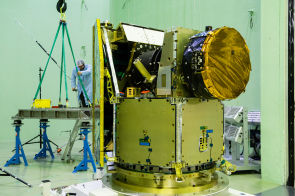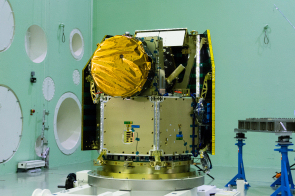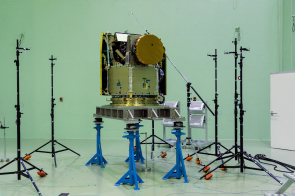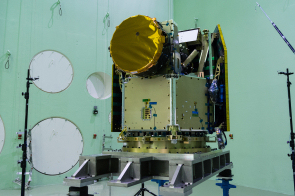#3: Simulated sound of launch for CHEOPS
11 November 2015
The CHEOPS spacecraft continues its fast-track implementation with a whistle-stop tour of test centres in Europe. Having completed acoustic tests at the European Space Research and Technology Centre in Noordwijk, the Netherlands, CHEOPS is on the road again. Next stop: Madrid.The spacecraft arrived at ESTEC on Wednesday 4 November, fresh from having completed the sine vibration tests in the Zurich premises of RUAG, Switzerland. The trip to ESTEC was for the purposes of running acoustic tests in ESA's Large European Acoustic Facility (LEAF). Here, CHEOPS was to be subjected to the acoustic environment it will experience due to the noise of the launcher engines and the airflow passing over the fairing that protects it during its passage through the atmosphere into space.
During Wednesday and Thursday, the spacecraft – composed of the spacecraft platform Structural Qualification Model (SQM) and the Instrument Structural and Thermal Model (STM) – was prepared for the acoustic tests. First, alignment tests were carried out to confirm that nothing had been displaced during transport. Then the spacecraft was moved from the ground transport trolley, which is used for manoeuvring it in the test centre, onto a 'load-spreader' – a ground support structure that provides the necessary interface to the base of the spacecraft inside the reverberation chamber – before being readied to experience the 'noise' of launch. Accelerometers were placed at a number of locations on the spacecraft to record the effect of the tests.
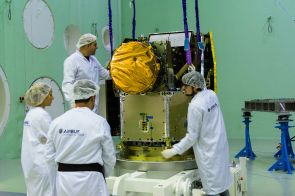 |
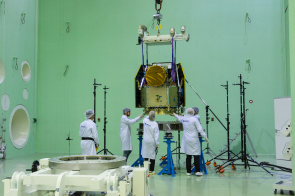 |
|
Transferring CHEOPS from its trolley onto the ground support structure in the LEAF chamber. Credit: ESA - C. Carreau |
|
With everything in place, on Friday 6 November a team of CHEOPS engineers and specialists from the ESTEC test centre performed three acoustic tests. The first and last were low-level noise tests, which were done to verify the integrity of the complete spacecraft structure before and after the tests at qualification level. Since the launcher for CHEOPS has not yet been selected the qualification test was executed at acoustic sound pressure levels that are compatible with several possible launchers.
With these acoustic tests successfully completed, it was time to carry out another alignment test and then to pack up again in preparation for the next port of call: EADS CASA, Madrid. There, engineers will carry out shock tests, specifically a clamp-band release test. The clamp-band release test is performed to demonstrate that the spacecraft can withstand the mechanical shocks it will experience when the spacecraft detaches from the launch adapter.
The final test to be performed on the spacecraft structural model will be to check that the instrument cover, which opens with a release mechanism, has come unscathed through the entire set of environmental tests.
At the end of this series of tests the platform SQM will be refurbished into the flight model. The platform panels, structural beams, and solar array substrates of the CHEOPS SQM are all the final flight elements. For the purposes of the qualification tests, dummy models of the subsystem units that are mechanically and structurally representative of the flight model have been used. These will be replaced with the functional subsystems during the refurbishment.
The instrument STM will return to the University of Bern, where the manufacturing of several units of the instrument flight model has already started. Integration and testing of the instrument flight model is expected to take place throughout 2016 and the first quarter of 2017.
By the end of the year, CHEOPS will have completed the satellite level SQM test campaign as well as the first part of the Electrical and Functional Model (EFM) test campaign.
About CHEOPS
CHEOPS is an ESA mission implemented in partnership with Switzerland, through the Swiss Space Office (SSO). The University of Bern leads a consortium of 11 ESA Member States contributing to the mission and represented in the CHEOPS Science Team. ESA is the mission architect responsible for overall mission definition and procurement of the spacecraft and launch. ESA is also responsible for early operations phase that will be executed by the spacecraft contractor, EADS CASA Espacio S.L., which is part of Airbus Defence and Space. The science instrument is led by the University of Bern, with important contributions from Austria, Belgium, Germany and Italy. Other contributions to the science instrument, in the form of hardware or science operations, are provided by Hungary and by France, Portugal, Sweden and the United Kingdom respectively. Following successful in-orbit commissioning of the spacecraft, responsibility for operations will be taken over by the CHEOPS Mission Consortium, with the Mission Operations Centre under the responsibility of Spain and the Science Operations Centre led by and located at the University of Geneva, Switzerland.

